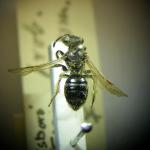On 11 May 1939, E Ernest collected a female of this bee at Princes Risborough, Buckinghamshire (Yarrow & Guichard, 1941). This remains the only record for the bee in Britain. The specimen is in the collection of the Natural History Museum, London.
This bee occurs throughout much of central and southern Europe (Dylewska, 1987) but is uncommon. There are apparently no records from Fennoscandia, Spain, Italy and the Mediterranean islands (Gusenleitner & Schwarz, 2002).
The species is listed as Endangered (RDB1) in the British Red Data Book (Shirt, 1987) and Falk (1991). However, serious consideration should be given as to whether this bee has ever been a resident in Britain.
Not known.
Bivoltine; the spring brood flies in April and May, the summer one in July and August.
In mainland Europe the species nests solitarily in sandy and loamy soils (Kocourek, 1966; Dylewska, 1987).
In mainland Europe the bee visits the following species. Spring brood: shepherd’s-purse, hoary cress, rape, turnip, charlock, wild radish, a cinquefoil, a speedwell, a dandelion. Summer brood: hoary alison, shepherd’s-purse, rape, turnip, charlock, wild radish, a cinquefoil, wild carrot, sheep’s-bit. The British record was probably collected from a willow flower (Yarrow & Guichard, 1941).
No data available.
2016


